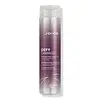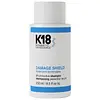What's inside
What's inside
 Key Ingredients
Key Ingredients

 Benefits
Benefits

 Concerns
Concerns

 Ingredients Side-by-side
Ingredients Side-by-side

Water
Skin ConditioningSodium C14-16 Olefin Sulfonate
CleansingCocamidopropyl Betaine
CleansingSodium Methyl Cocoyl Taurate
CleansingSodium Lauroamphoacetate
CleansingLauryl Glucoside
CleansingDisodium Laureth Sulfosuccinate
CleansingBetaine
HumectantPhenoxyethanol
PreservativeSodium Lauryl Sulfoacetate
CleansingDimethicone Propyl Pg-Betaine
CleansingArginine
MaskingAvena Sativa Peptide
Skin ConditioningPhosphatidylcholine
EmulsifyingMoringa Oleifera Seed Oil
EmollientLaurdimonium Hydroxypropyl Hydrolyzed Keratin
Skin ConditioningArginine Hcl
Skin ConditioningGlycol Distearate
EmollientGuar Hydroxypropyltrimonium Chloride
Skin ConditioningIsostearamide Mipa
Polyquaternium-47
Skin ConditioningCitric Acid
BufferingPolyquaternium-7
Laureth-4
EmulsifyingPEG-120 Methyl Glucose Dioleate
EmulsifyingDimethicone PEG-8 Meadowfoamate
EmollientPEG-4 Laurate
EmulsifyingQuaternium-80
Methyl Gluceth-10
EmulsifyingMethoxy PEG/PPG-7/3 Aminopropyl Dimethicone
Tetrasodium EDTA
Glyceryl Laurate
EmollientTocopherol
AntioxidantRosa Canina Fruit Oil
EmollientDipropylene Glycol
HumectantC10-40 Isoalkylamidopropylethyldimonium Ethosulfate
Sodium Hydroxide
BufferingIodopropynyl Butylcarbamate
PreservativeCitronellol
PerfumingParfum
MaskingWater, Sodium C14-16 Olefin Sulfonate, Cocamidopropyl Betaine, Sodium Methyl Cocoyl Taurate, Sodium Lauroamphoacetate, Lauryl Glucoside, Disodium Laureth Sulfosuccinate, Betaine, Phenoxyethanol, Sodium Lauryl Sulfoacetate, Dimethicone Propyl Pg-Betaine, Arginine, Avena Sativa Peptide, Phosphatidylcholine, Moringa Oleifera Seed Oil, Laurdimonium Hydroxypropyl Hydrolyzed Keratin, Arginine Hcl, Glycol Distearate, Guar Hydroxypropyltrimonium Chloride, Isostearamide Mipa, Polyquaternium-47, Citric Acid, Polyquaternium-7, Laureth-4, PEG-120 Methyl Glucose Dioleate, Dimethicone PEG-8 Meadowfoamate, PEG-4 Laurate, Quaternium-80, Methyl Gluceth-10, Methoxy PEG/PPG-7/3 Aminopropyl Dimethicone, Tetrasodium EDTA, Glyceryl Laurate, Tocopherol, Rosa Canina Fruit Oil, Dipropylene Glycol, C10-40 Isoalkylamidopropylethyldimonium Ethosulfate, Sodium Hydroxide, Iodopropynyl Butylcarbamate, Citronellol, Parfum
Water
Skin ConditioningSodium C14-16 Olefin Sulfonate
CleansingCocamidopropyl Betaine
CleansingSodium Methyl 2-Sulfolaurate
CleansingSodium Lauryl Sulfoacetate
CleansingSh-Oligopeptide-78
Panthenol
Skin ConditioningGlycerin
HumectantSodium Phytate
Guar Hydroxypropyltrimonium Chloride
Skin ConditioningDisodium 2-Sulfolaurate
CleansingCaprylyl Glycol
EmollientCaprylhydroxamic Acid
Benzoic Acid
MaskingCitric Acid
BufferingSodium Hydroxide
BufferingSodium Chloride
MaskingParfum
MaskingLimonene
PerfumingWater, Sodium C14-16 Olefin Sulfonate, Cocamidopropyl Betaine, Sodium Methyl 2-Sulfolaurate, Sodium Lauryl Sulfoacetate, Sh-Oligopeptide-78, Panthenol, Glycerin, Sodium Phytate, Guar Hydroxypropyltrimonium Chloride, Disodium 2-Sulfolaurate, Caprylyl Glycol, Caprylhydroxamic Acid, Benzoic Acid, Citric Acid, Sodium Hydroxide, Sodium Chloride, Parfum, Limonene
 Reviews
Reviews

Ingredients Explained
These ingredients are found in both products.
Ingredients higher up in an ingredient list are typically present in a larger amount.
Citric Acid is an alpha hydroxy acid (AHA) naturally found in citrus fruits like oranges, lemons, and limes.
Like other AHAs, citric acid can exfoliate skin by breaking down the bonds that hold dead skin cells together. This helps reveal smoother and brighter skin underneath.
However, this exfoliating effect only happens at high concentrations (20%) which can be hard to find in cosmetic products.
Due to this, citric acid is usually included in small amounts as a pH adjuster. This helps keep products slightly more acidic and compatible with skin's natural pH.
In skincare formulas, citric acid can:
While it can provide some skin benefits, research shows lactic acid and glycolic acid are generally more effective and less irritating exfoliants.
Most citric acid used in skincare today is made by fermenting sugars (usually from molasses). This synthetic version is identical to the natural citrus form but easier to stabilize and use in formulations.
Read more about some other popular AHA's here:
Learn more about Citric AcidCocamidopropyl Betaine is a fatty acid created by mixing similar compounds in coconut oil and dimethylaminopropylamine, a compound with two amino groups.
This ingredient is a surfactant and cleanser. It helps gather the dirt, pollutants, and other impurities in your skin to be washed away. It also helps thicken a product and make the texture more creamy.
Being created from coconut oil means Cocamidopropyl Betaine is hydrating for the skin.
While Cocamidopropyl Betaine was believed to be an allergen, a study from 2012 disproved this. It found two compounds in unpure Cocamidopropyl Betaine to be the irritants: aminoamide and 3-dimethylaminopropylamine. High-grade and pure Cocamidopropyl Betaine did not induce allergic reactions during this study.
Learn more about Cocamidopropyl BetaineThis ingredient is derived from guar gum.
It is a conditioning ingredient, meaning it helps soften skin and hair.
Parfum is a catch-all term for an ingredient or more that is used to give a scent to products.
Also called "fragrance", this ingredient can be a blend of hundreds of chemicals or plant oils. This means every product with "fragrance" or "parfum" in the ingredients list is a different mixture.
For instance, Habanolide is a proprietary trade name for a specific aroma chemical. When used as a fragrance ingredient in cosmetics, most aroma chemicals fall under the broad labeling category of “FRAGRANCE” or “PARFUM” according to EU and US regulations.
The term 'parfum' or 'fragrance' is not regulated in many countries. In many cases, it is up to the brand to define this term.
For instance, many brands choose to label themselves as "fragrance-free" because they are not using synthetic fragrances. However, their products may still contain ingredients such as essential oils that are considered a fragrance by INCI standards.
One example is Calendula flower extract. Calendula is an essential oil that still imparts a scent or 'fragrance'.
Depending on the blend, the ingredients in the mixture can cause allergies and sensitivities on the skin. Some ingredients that are known EU allergens include linalool and citronellol.
Parfum can also be used to mask or cover an unpleasant scent.
The bottom line is: not all fragrances/parfum/ingredients are created equally. If you are worried about fragrances, we recommend taking a closer look at an ingredient. And of course, we always recommend speaking with a professional.
Learn more about ParfumSodium C14-16 Olefin Sulfonate is a cleansing agent made from a mixture of long chain sulfonate salts. It can also help produce foam.
This ingredient may be drying. We recommend speaking with a professional if you have concerns.
Sodium Hydroxide is also known as lye or caustic soda. It is used to adjust the pH of products; many ingredients require a specific pH to be effective.
In small amounts, sodium hydroxide is considered safe to use. However, large amounts may cause chemical burns due to its high alkaline.
Your skin has a natural pH and acid mantle. This acid mantle helps prevent harmful bacteria from breaking through. The acid mantle also helps keep your skin hydrated.
"Alkaline" refers to a high pH level. A low pH level would be considered acidic.
Learn more about Sodium HydroxideSodium Lauryl Sulfoacetate is an organic salt with a naturally sweet odor. It is an alternative to traditional sulfates and is commonly found in "sulfate-free" products.
In cosmetics, this ingredient is used to increase the volume of foam, emulsify ingredients, and as a cleansing agent.
As a cleansing agent, sodium lauryl sulfoacetate helps reduce the surface tension of dirt, oil, and other pollutants so they can be rinsed away easily.
Cosmetic Ingredient Review found this ingredient to irritate the eyes and skin in concentrations of 0.18% and 0.7%.
Learn more about Sodium Lauryl SulfoacetateWater. It's the most common cosmetic ingredient of all. You'll usually see it at the top of ingredient lists, meaning that it makes up the largest part of the product.
So why is it so popular? Water most often acts as a solvent - this means that it helps dissolve other ingredients into the formulation.
You'll also recognize water as that liquid we all need to stay alive. If you see this, drink a glass of water. Stay hydrated!
Learn more about Water